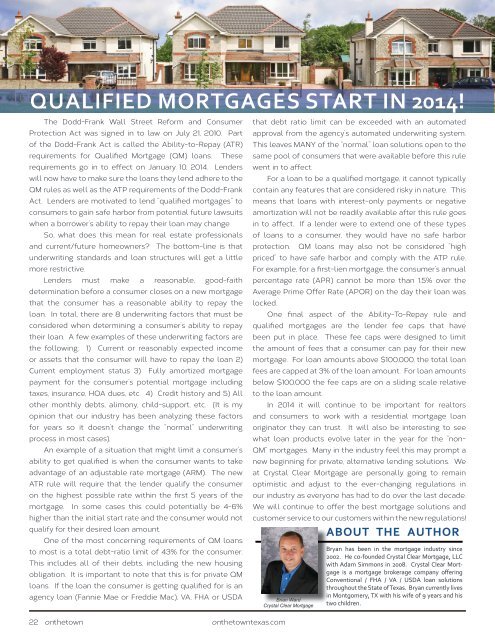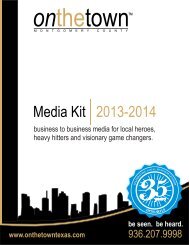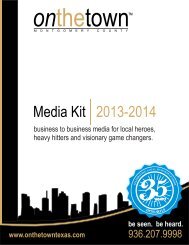You also want an ePaper? Increase the reach of your titles
YUMPU automatically turns print PDFs into web optimized ePapers that Google loves.
qualified mortgages start in 2014!<br />
The Dodd-Frank Wall Street Reform and Consumer<br />
Protection Act was signed in to law on July 21, 2010. Part<br />
of the Dodd-Frank Act is called the Ability-to-Repay (ATR)<br />
requirements for Qualified Mortgage (QM) loans. These<br />
requirements go in to effect on January 10, 2014. Lenders<br />
will now have to make sure the loans they lend adhere to the<br />
QM rules as well as the ATP requirements of the Dodd-Frank<br />
Act. Lenders are motivated to lend “qualified mortgages” to<br />
consumers to gain safe harbor from potential future lawsuits<br />
when a borrower’s ability to repay their loan may change<br />
So, what does this mean for real estate professionals<br />
and current/future homeowners? The bottom-line is that<br />
underwriting standards and loan structures will get a little<br />
more restrictive.<br />
Lenders must make a reasonable, good-faith<br />
determination before a consumer closes on a new mortgage<br />
that the consumer has a reasonable ability to repay the<br />
loan. In total, there are 8 underwriting factors that must be<br />
considered when determining a consumer’s ability to repay<br />
their loan. A few examples of these underwriting factors are<br />
the following: 1) Current or reasonably expected income<br />
or assets that the consumer will have to repay the loan 2)<br />
Current employment status 3) Fully amortized mortgage<br />
payment for the consumer’s potential mortgage including<br />
taxes, insurance, HOA dues, etc. 4) Credit history and 5) All<br />
other monthly debts, alimony, child-support, etc. (It is my<br />
opinion that our industry has been analyzing these factors<br />
for years so it doesn’t change the “normal” underwriting<br />
process in most cases).<br />
An example of a situation that might limit a consumer’s<br />
ability to get qualified is when the consumer wants to take<br />
advantage of an adjustable rate mortgage (ARM). The new<br />
ATR rule will require that the lender qualify the consumer<br />
on the highest possible rate within the first 5 years of the<br />
mortgage. In some cases this could potentially be 4-6%<br />
higher than the initial start rate and the consumer would not<br />
qualify for their desired loan amount.<br />
One of the most concerning requirements of QM loans<br />
to most is a total debt-ratio limit of 43% for the consumer.<br />
This includes all of their debts, including the new housing<br />
obligation. It is important to note that this is for private QM<br />
loans. If the loan the consumer is getting qualified for is an<br />
agency loan (Fannie Mae or Freddie Mac), VA, FHA or USDA<br />
22 onthetown onthetowntexas.com<br />
that debt ratio limit can be exceeded with an automated<br />
approval from the agency’s automated underwriting system.<br />
This leaves MANY of the “normal” loan solutions open to the<br />
same pool of consumers that were available before this rule<br />
went in to affect.<br />
For a loan to be a qualified mortgage, it cannot typically<br />
contain any features that are considered risky in nature. This<br />
means that loans with interest-only payments or negative<br />
amortization will not be readily available after this rule goes<br />
in to affect. If a lender were to extend one of these types<br />
of loans to a consumer, they would have no safe harbor<br />
protection. QM loans may also not be considered “high<br />
priced” to have safe harbor and comply with the ATP rule.<br />
For example, for a first-lien mortgage, the consumer’s annual<br />
percentage rate (APR) cannot be more than 1.5% over the<br />
Average Prime Offer Rate (APOR) on the day their loan was<br />
locked.<br />
One final aspect of the Ability-To-Repay rule and<br />
qualified mortgages are the lender fee caps that have<br />
been put in place. These fee caps were designed to limit<br />
the amount of fees that a consumer can pay for their new<br />
mortgage. For loan amounts above $100,000, the total loan<br />
fees are capped at 3% of the loan amount. For loan amounts<br />
below $100,000 the fee caps are on a sliding scale relative<br />
to the loan amount.<br />
In 2014 it will continue to be important for realtors<br />
and consumers to work with a residential mortgage loan<br />
originator they can trust. It will also be interesting to see<br />
what loan products evolve later in the year for the “non-<br />
QM” mortgages. Many in the industry feel this may prompt a<br />
new beginning for private, alternative lending solutions. We<br />
at Crystal Clear Mortgage are personally going to remain<br />
optimistic and adjust to the ever-changing regulations in<br />
our industry as everyone has had to do over the last decade.<br />
We will continue to offer the best mortgage solutions and<br />
customer service to our customers within the new regulations!<br />
Brian Ward<br />
Crystal Clear Mortgage<br />
ABOUT THE AUTHOR<br />
Bryan has been in the mortgage industry since<br />
2002. He co-founded Crystal Clear Mortgage, LLC<br />
with Adam Simmons in 2008. Crystal Clear Mortgage<br />
is a mortgage brokerage company offering<br />
Conventional / FHA / VA / USDA loan solutions<br />
throughout the State of Texas. Bryan currently lives<br />
in Montgomery, TX with his wife of 9 years and his<br />
two children.<br />
OTT Texas JanFeb Issue.indd 22<br />
1/28/2014 1:23:57 PM






